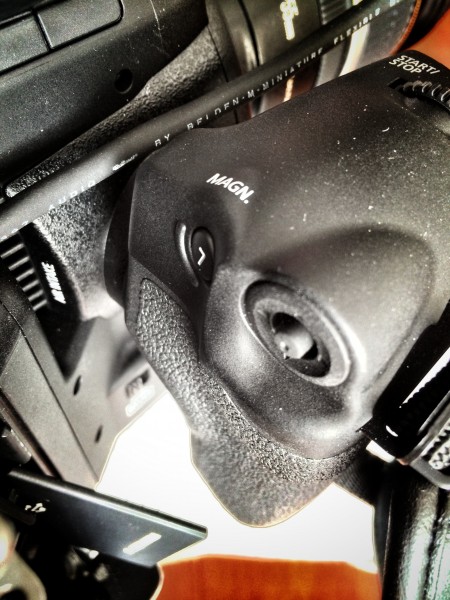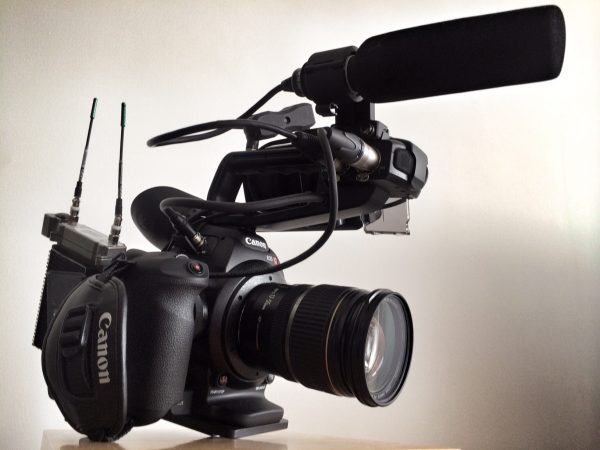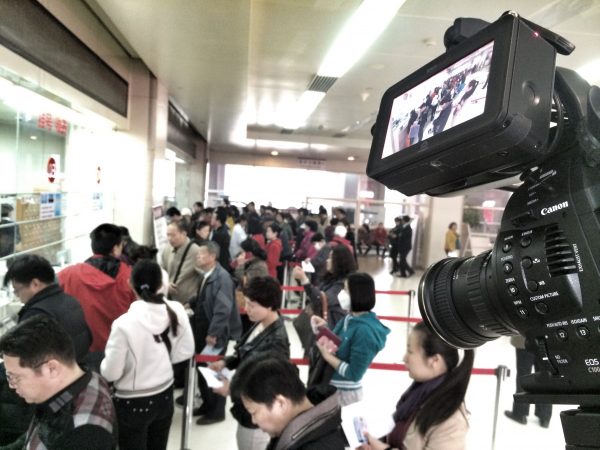By site editor Dan Chung:
Dual Pixel AF on the EOS C100 Digital Video Camera from Canon Pro on Vimeo.
Canon have posted a video of the infamous Philip Bloom talking about the C100 Dual Pixel CMOS AF upgrade. I received my own AF-upgraded C100 this week and immediately put it to work on a TV shoot (sadly, I can’t publish that video here). Phil’s findings are very similar to my own – the AF system is a great aid to getting quick focus on subjects when they have good contrast, and are in the centre of the frame. If the subject is low in contrast, or is backlit, then it can struggle to achieve focus at all.

I strongly recommend using the ‘back button’ focus technique with the upgraded C100. Anyone who has come from a news or sports photography background will instantly know what I am talking about. Button 7, usually the magnify button on the handgrip, can be reconfigured to activate and deactivate the AF system. Better still, with most USM lenses you can instantly grab the barrel and switch to manual focus the moment you toggle off the AF system.

For static off-centre shots you simply place the focus box over the subject, hit button 7, get focus, release the button and recompose. This is exactly how I have worked in stills mode on EOS DSLRs for over twenty years now. If you have a low contrast subject you can look for an object with more contrast in the same plane, focus on that, then recompose. I would say that for my documentary shooting the AF system is working about 80% of the time. Not bad, but not foolproof. I shoot a lot in low light so in bright light I would expect this percentage to go up considerably. Being able to switch to manual focus almost instantly does allow me to get those other shots most of the time though.
As Phil notes the AF speed is very fast – too fast for a slow, smooth focus pull. You will still want to do this manually by hand or using a good follow focus, although I predict Canon will add varying AF speeds in future Cinema series cameras.
Oddly, one area where I have found the Dual Pixel CMOS AF doesn’t work so well is for interviews. Frank Redward found the same in our earlier look at the system. That’s because your subjects are rarely in the centre of the frame and therefore the eyes don’t fall in the AF box. Until Canon add an off centre AF function (I’m guessing not on the C100 and C300 models), the Sony NEX AF system on the FS700 actually does a better job of AF for interviews.
Using non-Canon brand lenses has also caused the AF system issues. My Sigma 18-35mm f1.8, an other wise great lens, does not autofocus at anything other than f1.8 with the C100. If you set any other aperture you have to use manual focus. I don’t see how this is resolved without some kind of factory update from Sigma.
It is also worth mentioning that the AF motors on most Canon lenses are not silent. The internal C100 microphones or a camera mounted shotgun mic are likely to pick up this low level noise and it can become annoying in quiet situations. In noisy environments the motor noise is less intrusive, but make sure you have a good audio solution that doesn’t rely on these mics if you want to sure your sound to be completely clean.

One thing that did annoy me was that the viewfinder AF status indicator is white/grey and sometimes hard to make out. It would be much better if when the AF is active the symbol showed in red. I hope Canon can add this option in firmware. Also it would be great if future Canon Cinema EOS cameras had another customisable button next to existing button 7, or near the trigger button. This could be used to perform the focus magnification check function which you loose when setting button seven to AF activation.
As I began to trust the AF system more I also found myself being happier using the C100’s built-in EVF. While no-where near as good as the one on the C300, or a dedicated external EVF, it is usable if AF is your main method of achieving accurate focus.
After a short time with the Dual Pixel CMOS AF system I don’t think I would want to live without it again for documentary or news shooting – it’s that useful. It speeds up my shooting speed greatly; so far, I believe that when using this hybrid AF/manual focus technique I get far more shots in focus than I would just focusing by hand. I haven’t tested fully on a Steadicam or brushless gimbal yet but as Phil’s video shows it can be made to work well – especially if the handgrip can be moved a location on the gimbal or Steadicam where button 7 can be activated while shooting.
For more controlled work I would still prefer manual focus and as I’ve said many times before, AF does not replace a good follow focus and a skilled focus-puller on big budget productions. Also, while Canon AF lenses are optically good, I still prefer the image from manual cine and stills lenses like those from Zeiss.
Strangely for one of Canon’s own videos there is a small mistake where Phil says that pretty much all Canon AF lenses can be used. This isn’t true as there is a quite lengthy list of exclusions as detailed on the Canon CPN site here.






